The legacy of Ridley Scott’s ALIEN cultural phenomenon remains in 2017, but the classic tale of space-set terror has been influencing filmmakers since about ten minutes after the first screening of the film let out in 1979. Any self-respecting horror fan is more than aware of the endless ALIEN-inspired films that came in its wake, whether they be set in space (like GALAXY OF TERROR or INSEMINOID, or even this year’s LIFE) or underwater (like LEVIATHAN or DEEP STAR SIX) or in the apocalyptic ruins of Earth (like THE TERROR WITHIN). Viewers can certainly take their pick as to how they like to see a group of characters in a small, isolated location get picked off one by one by some mutated or alien presence.
The film has certainly spawned several direct parodies as well, ranging from John Hurt’s memorable reprise of his chest-bursting moment in SPACEBALLS to Bruce Kimmell’s musical take-off SPACESHIP (re-released as NAKED SPACE to cash in on star Leslie Nielsen’s NAKED GUN series) to Lenny Henry and Tracy Ullman making their mark on it in the BBC sketch show Three of a Kind.
One of the cleverest, however, is 1981’s ILLEGAL ALIEN, a 17-minutes short film in the vein of Ernie Fosselius’s HARDWARE WARS. While ILLEGAL ALIEN has never quite received the level of infamy as HARDWARE WARS, it’s an impressively funny work, essentially a condensed, “Mad Magazine” version of ALIEN that features lots of jokes that still work, a quick pace and plenty of sight gags that still seem fresh 34 years later. The film received some notoriety due to its inclusion on the VHS compilation film CINEMAGIC (later re-released as FRIGHT SHOW), which collected several horror-themed shorts to eager video store customers of the ‘80s. You can check it out in its entirety below:
The 16mm film was the directorial debut of Jeff Kwitny, then a college student. He would soon work with Roger Corman and eventually direct a few notable features to horror fans – the 1989 ski resort-themed slasher film ICED and the train-set non-sequel BEYOND THE DOOR III. Kwitny retired from filmmaking in the ‘90s, but took the time to talk with us about ILLEGAL ALIEN and his other projects from his home in California.
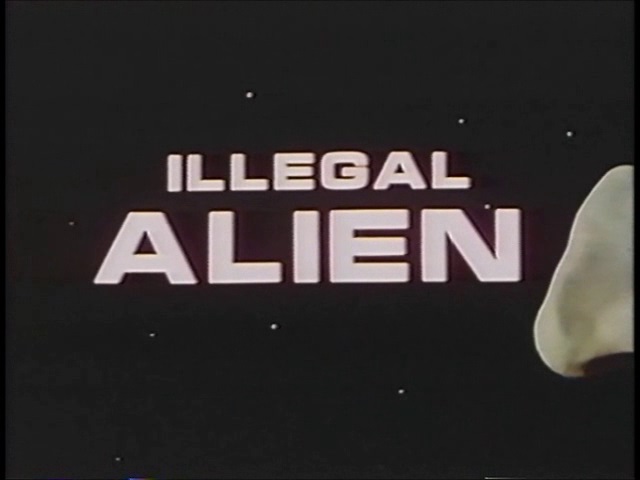
“My friends and I were part of a film community in San Francisco and we’d all work on each others’ movies,” Kwitny says about the origins of ILLEGAL ALIEN. “I wanted to do a parody of ALIEN. So we had a crew of about 12-5 people, and everyone was working for free. We shot it 16mm back in the days when we had cameras like Bolexes and Eclairs. Everybody volunteered, we all had day jobs and at night we would work on each others’ movies.”
Shot cheaply with a volunteer crew, building a set that could double for the ALIEN ship was an effort in resourcefulness. “We were working for free, so we pooled our money and we rented an empty warehouse in the south market district of San Francisco where we could get it really cheap. Just a big open space. And in there, we would come in there and build these sets out of plywood, and if you look at the surface of the walls inside the spaceship, you’ll see they’re all egg cartons. We just bought dozens of egg cartons and tacked them onto the wall and painted them! And it looks pretty good!”
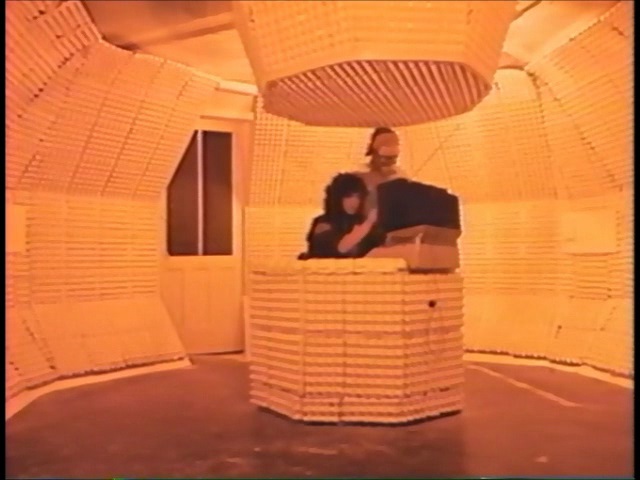
The replication of “space” in the film was particularly ingenious. “The starfield we did just by poking holes into black cardboard and shining a light through it. And it looks perfectly line! Look at the opening shot at that spaceship with that model going in front of the starfield – it was just ten holes in black colored cardboard! It works!”
The models in the film are especially impressive, with the first shot of the ship setting up several of the cocaine jokes that would later appear in the film. “The guy who made our spaceship models in ILLEGAL ALIEN – there’s this giant nose ship and all these spaceships. This guy, he built these giant models for us, they were four-five feet long, meticulously done, so he used our film to get a job at ILM up at San Rafael.”

“The actors were not actually immersed in ice,” Kwitny explains about the sequence where the crew emerges from refrigerators, “but what we did is we stretched plastic over the top of it and poked their heads through the plastic and dumped the ice onto the plastic so it looks like they’re completely immersed. We also threw in some frozen food with it.”
ILLEGAL ALIEN even duplicates the chest-bursting sequence using the same techniques used in ALIEN. “There’s the scene where one of the actors gets his chest burst open and the alien creature comes out of it. We basically duplicated Ridley Scott’s method, same technique. It’s really simple – we just have a dummy laying on a table and you just cut a hole through the table at the head, and you poke the actor’s head through it and attach the dummy to his head, and you can do whatever you want with the dummy. So his head just writhes around, but the torso’s a dummy. And that’s what Ridley Scott did! And I think it’s the scariest thing in ALIEN!”
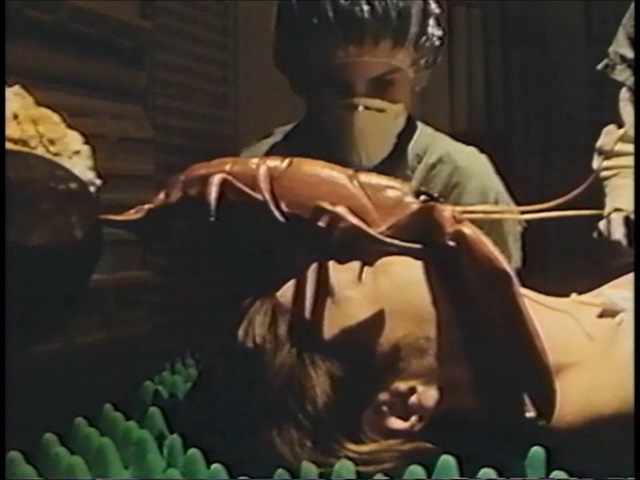
For the film’s climactic moment, the crew just blew up the model. “We did the exploding spaceship at the end by going into a parking lot really late at night. We had two poles and stretched a wire between the poles, and had the spaceship dangling from that wire, and we got on the ground below it and aimed the camera straight up. Then we blew up the model with fireworks, with the camera at 70 frames per second, a little bolex. We just had all the firey parts rain down on the camera! We weren’t there, we just turned it on and ran! And if you look at the film, it looks fantastic!”
ILLEGAL ALIEN even got the attention of ALIEN producer Walter Hill. “I called the executive producer of the original ALIEN here in Beverly Hills, I think it was Walter Hill, and he said, ‘I’d like to meet you.’ So I drove down to L.A., brought my copy of the film, and there he was in his office. He had this putting setup in his office, as though he was playing golf. He was really happy to meet me, and said he really appreciated it, and he said, ‘Would you mind if I gave a copy of this to Ridley?’ and I said, ‘Are you kidding? Yeah!’ So he got a copy of it to Ridley Scott. Somewhere in a box on a shelf somewhere, Ridley Scott has ILLEGAL ALIEN.”

The film played the festival circuit for a while before ending up on video, but has languished since. “They bought that out many years ago, along with a friend of mine’s film, Ernie Fosselius. [The director of HARDWARE WARS and PORKLIPS NOW] So Ernie and I were buddies. He was living in Berkeley at the time, and I was a student in Berekely, and we connected up. He was very supportive and helpful with the making of ILLEGAL ALIEN, so both of us got released on the Cinemagic VHS. That was the last I heard from them – I never made a penny on it. I don’t know whatever became of it. But when I saw it on YouTube recently, I saw it and it looks horrible! The print has got dirt on it, it’s obviously a poor video transfer. “
After ILLEGAL ALIEN, Kwitny worked for Roger Corman, a connection that awarded him a few notable contacts in the industry. “That’s where Jim Cameron and I met. We were both working there about the same time and Ovidio Assonitis recruited Jim from New World Entertainment in the mid-‘80s.“
Kwitny also ended up with a small role in RETURN OF THE JEDI. “I played one of the aliens in that. That’s the thing they like about me the best. When Princess Leia is being rescued from Jabba the Hut’s barge, Luke Skywalker grabs her, and he does this sort of Errol Flynn flying between one barge to another, and he lands on his own flying craft. He looks back, and the bad guys are coming from the barge on a hovercraft, and there are three aliens on it. I’m one of them. I’m the one shooting at him, and I get shot and fall into the pit. You can’t see me because I’m wearing a costume. “
“That was so much fun. We shot that in San Rafael and all the backdrops were blue screen that were shot in Arizona. I’m wearing a rubber costume holding a metal laser gun that had moveable parts that looked really cool. Everything Lucas did was meticulous. Everyone had a real working gun that fired that, even though it didn’t shoot real laser beams, it was heavy and felt like a real gun. Our costumes were all individualized. Everything was done meticulously. It was just quite fun, quite remarkable. Richard Marquand was directing that film. Those three films were my favorite of the Lucasfilm movies.”
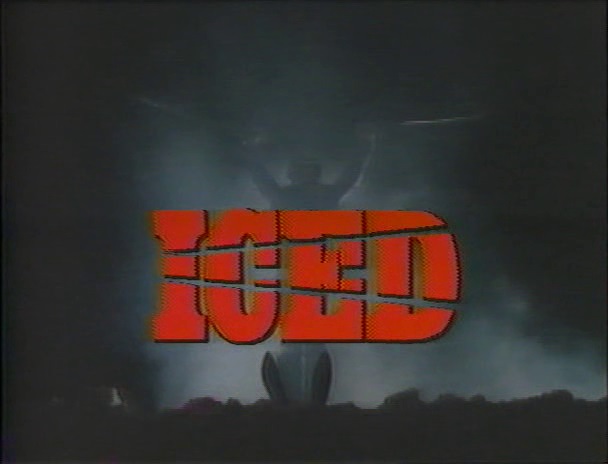
Kwitny continued working for Corman and attempting to get his own films made until 1987 brought him to ICED, a ski-resort set slasher film featuring Lisa Loring (the original Wednesday Addams) and written by and starring Joseph Alan Johnson (SLUMBER PARTY MASSACRE). While Kwitny calls the film “godawful,” he’s embraced the film’s cult following. “There are all kinds of blogs that are dedicated to horror films and slasher films, and ICED has this big following and it’s gotten all these great reviews, and it’s like this horribly terrible film! We shot that in 18 days in Utah in the mountains in the winter, and it was just… everybody involved was an amateur, but we had a lot of fun making it. It was a gas to make. Suddenly, that thing just took on a life of its own. “
“It was $150,000, and most of that, $90,000, was eaten up by the lab costs,” Kwitny says about the film’s production. “We got paid a little bit of money, but we weren’t doing it for the money, we were doing it for the credit. I needed the credit, and the reason I got the job is because I’d gotten ILLEGAL ALIEN, and that was the only film footage I had. I had gotten an agent for my writing and directing and he was representing some of the people in Joe Johnson’s group, so he introduced me to Joe, and Joe and I just hit it off. We saw eye to eye, and he knew he could work with me. He was producing the film, and I met the rest of the actors and they all were like me, and they realized I had next to no experience, which I didn’t, but we stumbled through the film and did the best we could.”
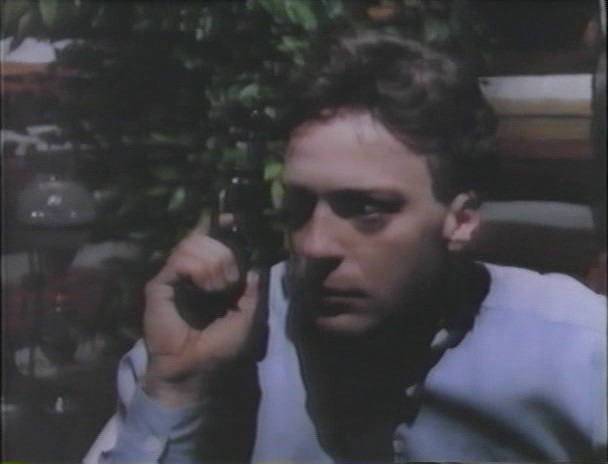
“We were using a gun in the scene where one of the good guys shoots at the bad guy, and we were using blanks, and for some reason, when he shot at Joe Johnston, a piece of the blank fired at him and hit him right below the left eye and broke open his skin. It just missed his eyeball by less than an inch. So we didn’t know what we were doing! We used real knives that didn’t retract because we couldn’t get a hold of any of them. So we had to figure out how to stab somebody with a real knife!”
“The thing about ICED is that all the actors were very earnest,” Kwitny adds. “Even though the script we were all aware was tongue-in-cheek. We didn’t take the script seriously, but the actors were all eager to be serious actors. They had all worked on SLUMBER PARTY MASSACRE together, so they were part of Roger Corman’s team.”
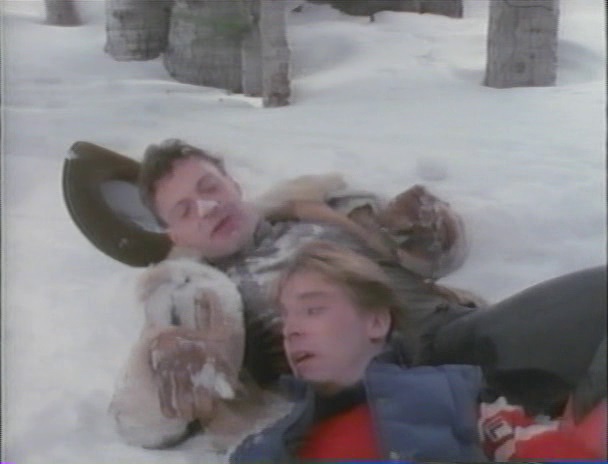
ICED was responsible for getting Kwitny his next project, the strange supernatural horror version of RUNAWAY TRAIN shot as AMOK TRAIN and released initially as BEYOND THE DOOR III in an effort to cash in on the success of producer Ovidio Assonitis’ 1974 possession film BEYOND THE DOOR. His previous connections warned him that it would be a difficult shoot.
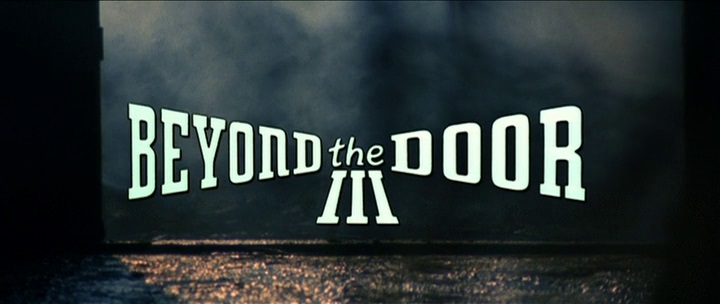
“I was working for Ovidio Assonitis in Rome, and he was the same producer of James Cameron’s PIRANHA II. So when I went to go make this film in Rome and Belgrade, I called Cameron, who was working on THE ABYSS at the time at 20th Century Fox, and I was surprised, he got right on the phone. He just said, ‘Jeff, do not do this film! Don’t work for those people! They’re horrible monsters!’ Cameron was fired halfway through [PIRANHA II] but refused to leave the set, and Ovidio took over, so he had all these wonderful stories to tell me about his experience. But I said, ‘Look, I don’t have any other film offers.’ So he warned me which people to watch out for. So I went and did that film.”
It was, if nothing else, a step up in terms of production size from ICED, even if the situation in the country made shooting more difficult. “The thing at least with BEYOND THE DOOR III is that at least Ovidio had experience making lots and lots of films, so at least we got some production value out of it. We shot that one in Belgrade during the civil war that was going on in 1989, so we got labor people to work for a dollar a day there, so we got a cast of thousands. So it was like a big production, but very inexpensive. The problem with making BEYOND THE DOOR III is that we were right in the middle of all this chaos that was going on in the country. Yugoslavia was unraveling, so it was mildly dangerous what we were doing at that time.”
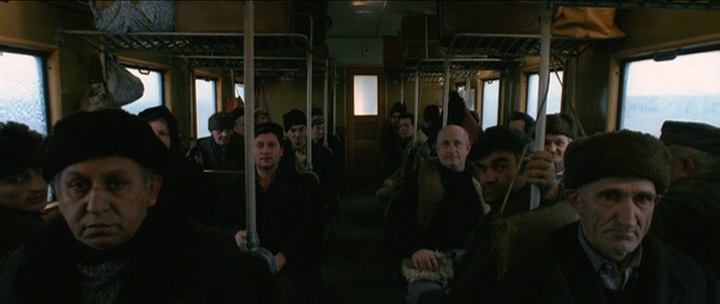
“Our days when we were shooting BEYOND THE DOOR III were 16-18 hour days every day. We were looking at dailies at 1 am and our call was 5 am the next morning. It was just brutal! When we were shooting the film, we had to have the Serbian army accompany us on the locations because it was so dangerous. They set up machine gun nests around our sets while we were out there shooting to protect us. I’m not making this up! It was just grueling and dangerous and weird – I had two crews that didn’t speak English, the Italian crew and the Serbian crew. I didn’t speak a word of their languages, so I had to have two full-time translators working with me. We’d have a production meeting at 9 at night, and I’d say I need this and that for tomorrow morning for the scene, and I’d get there the next morning and they’d mistranslated everything I’d said.”
While there were models in use for the special effects, much of the film was shot on an actual train. “We actually used a real train for about two or three weeks. We had a steam train that was at our disposal that we rented from the Yugoslavian government that we could do whatever we wanted with it. We had a blast! The problem was that you’d have a scene where the real train was coming down the tracks, but then I’d need to have it back up to shoot another take, but it would take an hour, because to back up a train and to get it going again would take about an hour. There were days I’d get there at 7 AM on the location for a train, and the train wouldn’t be there, so we’d have to come up with some other scenes to shoot without it. Sometimes it would show up by noon.”
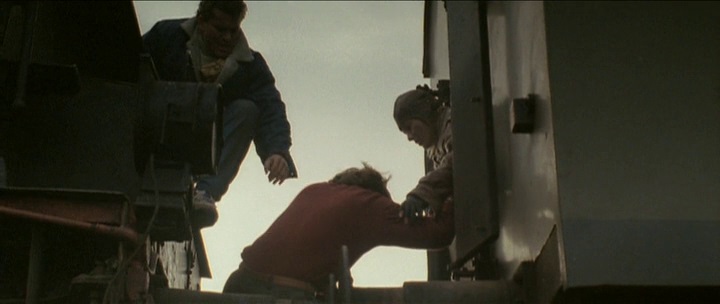
The film’s special effects were not done under Kwitny’s watch. “I just want to make a disclaimer here. Every single one of the special effects of people getting slaughtered [in BEYOND THE DOOR III] – I was not even in Rome at the time they were done. I had already flown home. The special effects crew had added all that stuff after I had left. When I look at it, I give it a D-. The effects in that movie, and the train model, are just atrocious.”
BEYOND THE DOOR III had a long life on cable, DVD and streaming services. “BEYOND THE DOOR III was all over Europe, and in this country, it was on Cinemax, and then it got bought by MGM, and it was on MGM’s channel for a while, and then it was on Netflix for years. And then they pulled it off, I think, not long ago.”
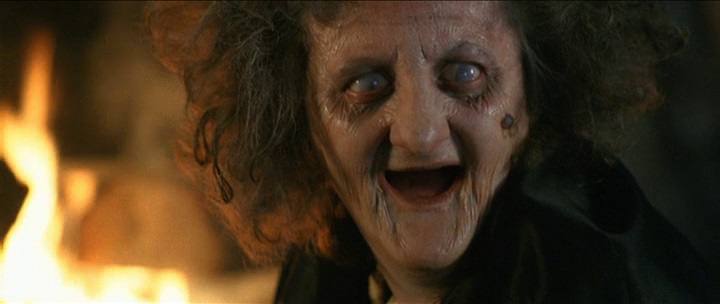
Next up for Kwitny was LIGHTNING IN A BOTTLE, a drama with Lynda Carter and Dee Wallace, in 1993. “It had Lynda Carter as the lead, and Dee Wallace. And Dee Wallace was a real method actress, she’s a really talented actress, and got all kinds of accolades for working with Steven Spielberg on E.T., and she also worked on 10 with Dudley Moore. She’s a wonderful actress. And Lynda Carter wanted to do some method acting, so she studied, and we got these two actresses that are very different. I just thought it was great.”
“Believe it or not, BEYOND THE DOOR III got me that job. I actually think that’s a halfway decent film. It actually won some awards. It got sold to a videocassette company that immediately killed it from being seen anywhere. I felt pretty good about it. It played briefly in the L.A. theaters and then went right to video. Then Lifetime bought it, and it played on Lifetime and it was shown-get this-80 times. It got great reviews on TV Guide and then it just went into oblivion. It’s hard to find. I have a VHS copy of it, but I wanted a DVD, so I found it online as a French DVD, so I bought it, and it’s completely dubbed in French! But at least I have a DVD of it. It’s a good film, but after that I stopped making movies, gave up on it, couldn’t take it anymore.”
Kwitny then turned to animation, where he worked on scripts for several shows, winning a Daytime Emmy for Animaniacs in 1996. “There was about three or four years where I worked for Warner Brothers animation, Tom Ruger was the producer. I worked on Pinky and the Brain and Animaniacs and Hysteria, which was a show I started up, and Road Rovers… actually about ten different animated shows. I worked for Hanna-Barbera, I worked for Disney… that was my bread and butter for several years. I actually picked up a Daytime Emmy Award for working on Animaniacs in 1995. I won for one of the episodes I’d written for them, so it was an interesting period, but after that, in 1997, I got burned out, got tired of the people I was working with, a lot of projects had fallen through. “
Theatrical film opportunities, however, fell through. “In 1995, I was supposed to direct a film called UNDERCURRENT, a script that I’d written, and we had the financing, and it was going to be Orion Pictures (that was a connection with Jim Cameron, who brought THE TERMINATOR to Orion, so I had that connection there). We had actors in place, Sarah Jessica Parker and Jason Patric, and we had the financing and we were going to shoot my script, and we had a crew and I was doing location scouting. The whole thing was just go, go, go, and then at the last minute, the company got a lawsuit and they folded production down and that’s about when I told my wife, ‘I can’t take this anymore. This is too much struggle, too much work, too little rewards.’ “
Kwitny left filmmaking and became a teacher. “And so in 1998, I started teaching. I have a Master’s degree in English from UC Berkeley, and I decided I think I need a steady job. So since then, I’ve been teaching and it’s been wonderful. I absolutely love teaching and I love what I do. I feel good about my life and the work I have to go to everyday. But we had some fun in those film years. I spent 20 years in the film business, and it’s been 20 years now in the teaching business. That’s my story!”
His students, now, are eager fans of his work. “They love my films. They’ve seen them all. Much to my embarrassment sometimes!“
Thanks to Jeff Kwitny for his time in conducting this interview.
- JIM WYNORSKI RETURNS WITH THE CREATURE FEATURE ‘GILA’ - May 1, 2014
Tags: Interviews, Jeff Kwitny, Profiles

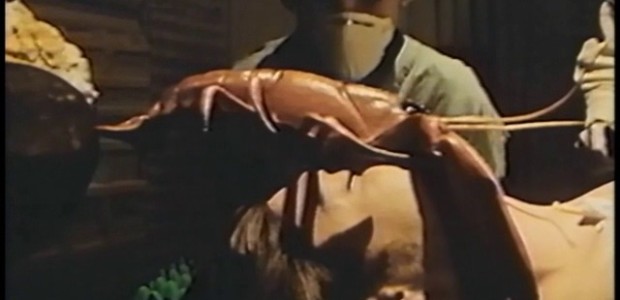

No Comments